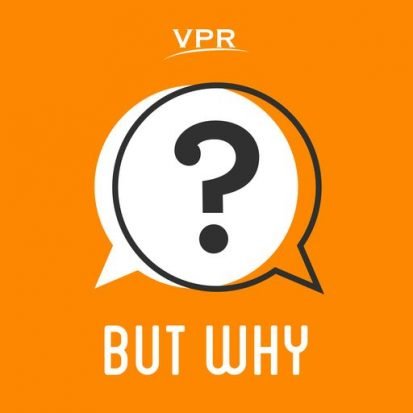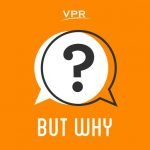
Why Are Fireworks Bright?
Leave a reviewWhat are fireworks made of, why are they bright and loud, and how do people make them? And, why do Americans celebrate the 4th of July with fireworks? We learn about pyrotechnics with licensed fireworks professional John Steinberg. And David Chavez, an explosives expert at Los Alamos National Laboratory tells us how changes to the materials used in fireworks can make them better for the environment and unleash new, more vibrant colors in the night sky. We also address firework safety and how to impress your friends by knowing what kinds of metals are in the fireworks you’re watching or the sparklers you’re playing with.
© Vermont Public Radio | 32:53
|Episode: 157 |
Full episode description
 Episode One: But Why: Intro For Adults
Episode One: But Why: Intro For Adults
This is an Episodic show. You can listen to it in any order, but episode one is always a great place to start.Full Episode description
What are fireworks made of, why are they bright and loud, and how do people make them? And, why do Americans celebrate the 4th of July with fireworks? We learn about pyrotechnics with licensed fireworks professional John Steinberg. And David Chavez, an explosives expert at Los Alamos National Laboratory tells us how changes to the materials used in fireworks can make them better for the environment and unleash new, more vibrant colors in the night sky. We also address firework safety and how to impress your friends by knowing what kinds of metals are in the fireworks you’re watching or the sparklers you’re playing with.
NOTE: We know not all kids (or adults) enjoy the noise of fireworks. We do play the sound of fireworks at the very beginning and very end of the episode. And John Steinberg offers some advice to people who dislike fireworks in the middle of the episode.
Download our learning guides: PDF | Google Slide | Transcript
Related episodes: Why Is Fire Orange? and How Do You Make Paint?
Resources: celebratesafely.org, Sparkler Safety Video, Fireworks Colors
Why are fireworks bright? –Dash, 4, Omaha, NE
Steinberg told But Why that the brightness is the main purpose of fireworks.
“You’re painting the in sky with light. It has to be bright enough to create the color and the effect you want to in the sky. Second, fireworks are explosive. You can’t be right up in front of it like a painting in an art gallery. You have to be some distance away, so the fireworks have to be bright enough for you to appreciate it,” he said.
Fireworks are created by burning materials that shine brightly when burned. Those fires are very hot! “The types of things we burn in fireworks burn very brightly, and they’re chosen for those properties,” Steinberg said.
Fireworks are created by a combustion in the sky – a combustion is something that burns.
“You need a fuel and you need something to burn that fuel,” Chavez said. “An example of a fuel would be gasoline or wood in a fireplace. In fireworks, the fuels are the chemicals that we use to make the firework itself. The oxidizer is another chemical. When those two things burn, they burn very hot. And those high temperatures excite the coloring agents that we have in fireworks.” The coloring agents are metals.
“Anytime you see red, that’s strontium. If you see a pinkish-purple, that’s potassium. Yellow is from sodium. Orange comes from calcium. The green is from barium, but now you can use boron. Blue is from copper. And these can be mixed to make other colors.
“You need a really hot fire to be able to excite these atoms, to make them give off their color. But when they are that hot, it makes the colors come out really bright.”
Chavez and other scientists have found ways to change the fuel source of fireworks to create less soot. Those changes also allowed them to replace barium, which can get into water sources, with boron, a greener way to create those green fireworks.
Support But Why | Newsletter Sign-Up
© Vermont Public Radiobop| Status: Active, 259 episodes | Kind: Episodic | Episode URL
The content, Artwork and advertising within this podcast is not owned or affiliated with Sound Carrot and remain the property of their respective owners.









